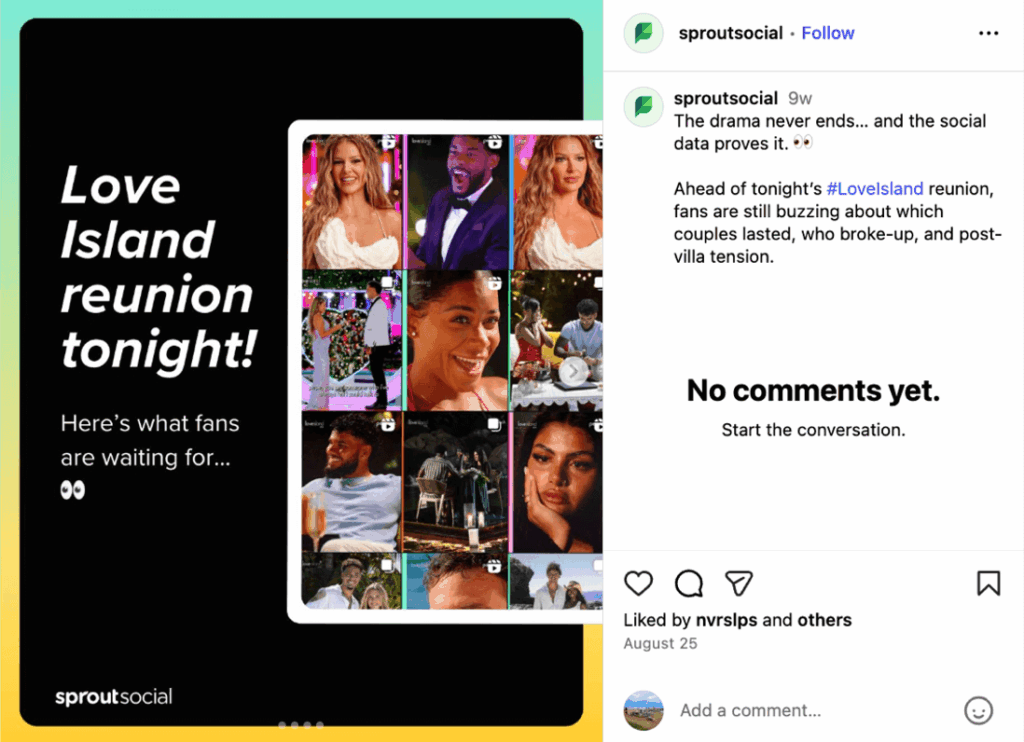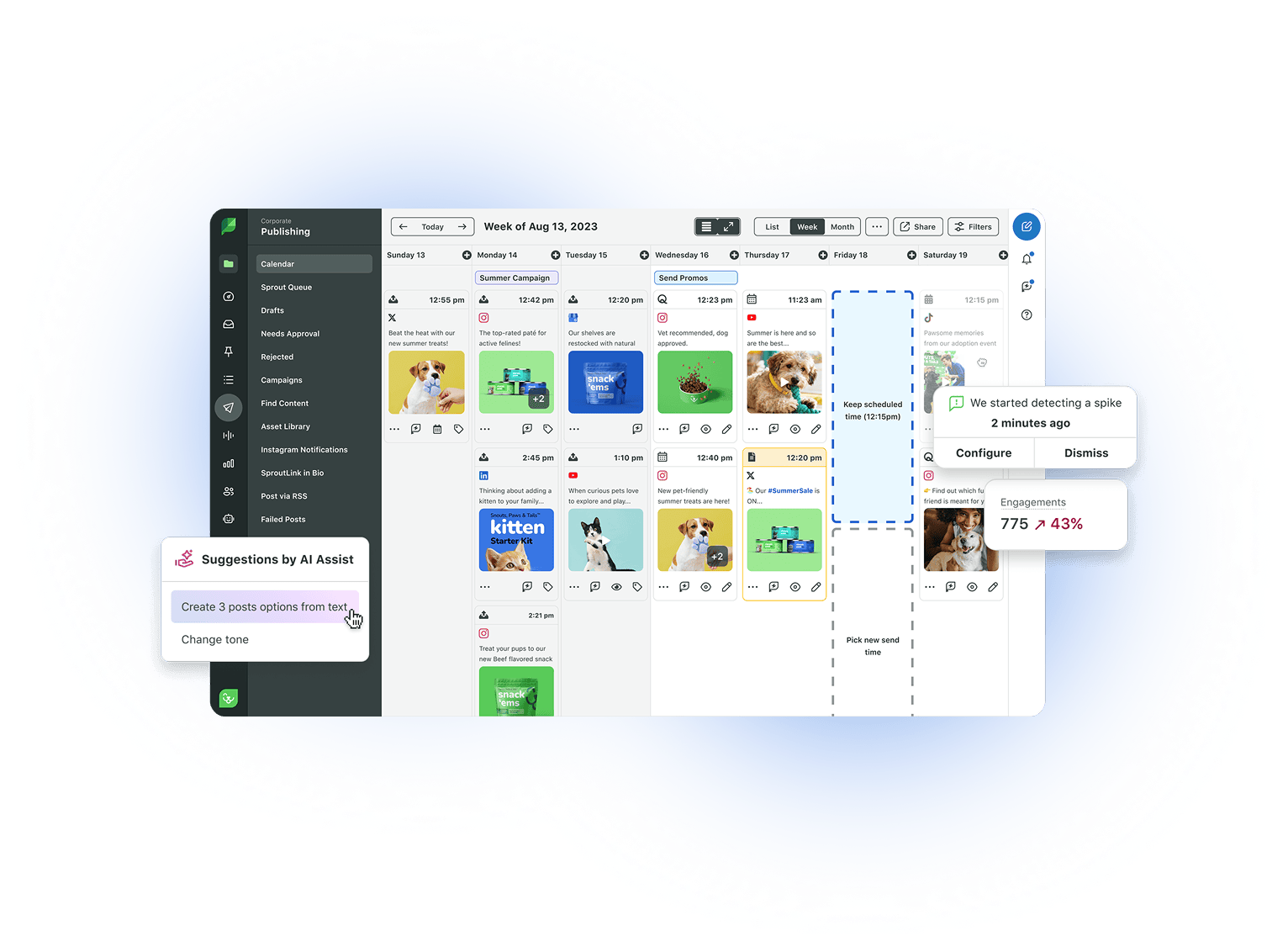How to use an AI social media assistant to amplify your team’s impact

Table of Contents
Social media managers are pulled in many directions, handling everything from a busy inbox and customer care to multiple campaigns running simultaneously. With so much tactical work on their plate, it’s hard to find time for big-picture strategy or creative ideas.
An AI social media assistant enhances a social media team’s impact by handling repetitive, time-consuming tasks, freeing up space for more strategic work—a need most consumers also recognize. According to the Q4 2025 Sprout Social Pulse Survey, 65% of global social users say they’re comfortable with brands using AI such as chatbots or other tools to help employees refine their responses and deliver faster customer service on social.
Agentic AI can further help social teams improve performance by using multi-step reasoning to support strategic work. It can help teams manage campaigns easily by coordinating and completing complex workflows, and it can also glean social intelligence from millions of data points to support the overall brand. All, while working in the background.
In this article, we’ll deep-dive into the role and benefits of an AI social media assistant in an organization. Plus, you’ll see how the Sprout social team uses AI in its daily operations.
Understanding the role of an AI social media assistant
When AI takes care of the tedious tasks, you reclaim time and mental bandwidth to focus on high-impact work that drives growth and innovation. That’s the true role of AI—a dependable digital teammate operating behind the scenes to streamline workflows and elevate efficiency.
AI improves your social media strategy by amplifying the personal touch. It enables you to engage more meaningfully with your audience while handling repetitive tasks that keep operations running smoothly.
This means more time for you to craft personalized content, build stronger connections with your audience and achieve the best results during peak seasons like the end-of-year holiday rush.
The holidays are also the time when relevant, relatable interactions are key to boosting brand loyalty and sales opportunities. According to Sprout’s Q4 2025 Pulse Survey, 73% of all social users will likely use social to contact a brand during the holiday season. They are most likely to contact brands on social via DMs this holiday season (49%), followed by comment sections (27%).

An agentic AI assistant acts as an extension of your team. It can support the execution of multi-step workflows and plan campaign sequences. Plus, it can mine billions of key data points across audience behavior, industry trends and competitors through social listening to provide crucial insights useful not only to social teams but also R&D, sales and marketing.
This AI-powered, behind-the-scenes support enables brands to overcome bandwidth challenges and drive broader business impact, all while maintaining a strategic edge.
Key areas where you can use AI and an agentic AI social media assistant
Let’s dive into the key areas AI and an agentic AI social media assistant can support your social media efforts.
Social listening and trendspotting
Social listening involves understanding what’s being said about your brand, products or industry across social channels. With AI, this becomes even more efficient and insightful.
For example, with Sprout Social’s Listening features, you can track conversations around key topics and trends without needing technical expertise. Features like Queries by AI Assist generate effective keyword suggestions for Listening topics, helping you capture the right audience insights.

And, Spike Alerts notify your team of sudden changes in engagement or sentiment, allowing for proactive responses during critical moments.

Similarly, Summarize by AI Assist helps you condense large datasets into clear, actionable summaries so you can quickly identify important trends.

Sprout’s agentic AI, Trellis, takes the capabilities of AI even further, acting as an assistant in the background to gather and deliver the insights your team needs, faster. It enables you to deep dive into trend analysis and learnings from your Social Listening data. You’re able to:
- Detect trends: Assess industry news, trends and potential disruptions
- Monitor your brand: Understand your brand’s overall status and perception all while monitoring for any changes in conversations
- Analyze competitors: Track and get insights for competitor activities and understand their market presence
- Use market research: Quicker and less expensive than traditional routes by using millions of data points to better understand a new market, industry, product category or audience.
You can get all these insights using a simple, conversational question. For instance, if you need to identify the top three conversational trends around a competitor’s new product, you can input that query into Trellis in a conversational form, such as, “What are the top 3 trends around ‘Competitor A’s’ new product?”
This combination of AI tools and an agentic AI assistant ensures you’re always ahead of market trends, able to respond quickly and refine your strategy based on real-time insights.
Performance analysis and content strategy
No social media strategy is complete without proper performance analytics and reporting. In fact, per the Social Media Productivity Report, 63% of marketers agree that manual tasks prevent them from focusing on high-impact work.
Instead of manually sifting through complex metrics, use AI tools to identify patterns, track performance and highlight key trends, all within minutes. This streamlined approach saves valuable time and ensures your reports are data-driven and actionable. It also enables you to focus on more strategic initiatives while keeping stakeholders informed of your progress in a clear, concise manner.

Targeted performance analysis also helps with strengthening content strategy, a task AI social media assistants can help with. For example, Trellis, our agentic AI, has a built-in ChatGPT Integration that enables you to optimize your content strategy directly within ChatGPT’s interface.
This way, you can use rich data to shape a strategy that resonates with your ICP without switching between tools to research, plan and execute your ideas.
Media monitoring
AI makes it easier for social teams to keep up with the news by doing the heavy lifting. Instead of teams spending hours scanning headlines or browsing multiple sites for relevant news, AI tools can automatically track news stories from around the world and pick out the ones that matter most to you. These tools spot mentions of your brand, competitors or key topics and also identify whether the coverage is positive or negative. They can also summarize long articles and highlight trends in real time, so you can react quickly without getting buried in information.
An example of such a media monitoring agentic AI tool is NewsWhip by Sprout Social. The tool continuously monitors news sources for brand mentions and emerging signals in real time. This enables you to have a proactive marketing approach, taking into consideration all events relevant to your brand and industry.
Content creation
According to The Social Media Productivity Report, 30% of social media marketers still handle content creation and approvals manually, which limits their ability to focus on high-impact work. AI can be a valuable ally on this front.
While AI may not always produce final, ready-to-publish content, it’s an excellent tool for jumpstarting the creative process. It can help brainstorm ideas, draft captions, suggest hashtags and also tailor copy for different audiences or platforms. AI support is especially valuable during busy periods and campaign peaks to maintain a consistent posting cadence. It helps you fill content gaps and stay on brand without sacrificing quality or authenticity.
Content curation
Curating relevant, high-quality content for your audience is time-consuming and requires sifting through countless articles, posts and media. This is another area where an AI social media assistant can help social media teams quickly identify trending topics, gather industry-relevant content and even suggest pieces that align with your audience’s interests.
And since AI tools can analyze vast amounts of data from multiple sources, including news outlets, to surface valuable content worth sharing, they help you maintain an active and relevant social presence during peak seasons.
Optimizing content schedules
Even the most compelling social content may go unnoticed if it’s not posted at the right time. You should post when your audience is most active to boost engagement and drive better campaign results.
AI tools can help determine these optimal times for you to schedule content. For example, Sprout’s Optimal Send Times feature simplifies scheduling by analyzing your audience’s behavior patterns and past engagement data. It recommends the best times to post, ensuring you connect with your audience when they’re most likely to interact.

This automation ensures your content consistently aligns with peak engagement periods, maximizing the impact of every post.
Message intent and classification
AI-powered sentiment analysis, combined with direct messaging, significantly aids social customer care teams in managing their inbox. It classifies and labels messages, making prioritizing responses easier and helping you differentiate between customer care requests and marketing engagements.
Sprout’s message classification capability automatically sorts incoming messages based on their content, enabling teams to identify what requires immediate attention.
Sprout’s message intent capability further analyzes the purpose behind each message. It tells you whether it’s a support request, feedback or a general inquiry—enabling teams to respond more efficiently and effectively. This streamlines customer care and ensures that no important interactions are overlooked.
How Sprout’s social media team uses AI and an AI social media assistant
Here’s a breakdown of how Sprout’s social media team uses AI to maintain a consistent and strategic brand presence, freeing up time to focus on other creative, high-impact work.
Use case #1: Content ideation
Content ideation is a critical part of any social media team’s role as it drives the topics, themes and messages that engage audiences and support brand goals. Yet generating fresh, relevant ideas consistently can be a major challenge and even the best teams often face creative blocks.
The Sprout Social team uses AI to make content ideation easier and more fun. By looking at audience interests, trending topics and what competitors are doing, AI suggests new ideas, captions and hashtags. In doing so, it helps our social team stay on top of what really resonates without feeling overwhelmed.
Plus, Sprout’s AI Assist tool not only speeds up the brainstorming process but also ensures content remains engaging, relevant and aligned with the overall strategy.
Autumn Benitez, Sprout’s Social Media Specialist, says, “All social media managers know that crafting the *perfect* caption can take forever, trying to make them clever, on-brand and scroll-stopping. AI Assist helps me speed that process up with its suggestions, without sacrificing quality, keeping the content pipeline flowing, especially during peak campaign season.”
“Here’s a recent LinkedIn post where I used AI Assist to spruce up the caption,” she shares.
Takeaway: AI makes content ideation faster and less stressful for social teams. By suggesting ideas, captions and hashtags based on trends and audience interests, it helps create content that truly connects.
Use case #2: Content planning
Social media teams plan content by organizing ideas into a structured calendar that outlines what to post, when to post it and on which networks. Having AI act as an assistant to help with these operational efforts gives back time to the team.
Sprout’s AI helps our social team optimize their posting by analyzing audience engagement data to recommend the best times to share content. It also streamlines scheduling with a centralized social calendar, which enables Sprout’s social team to plan, queue and publish posts across multiple networks more efficiently.
Takeaway: AI tools help streamline content planning by organizing posts, filling calendar gaps and recommending optimal publish times. This enables social teams to maintain a consistent, strategic brand presence while focusing on higher-level creative work.
Use case #3: Social listening
Sprout’s AI functionality helps our social team by automatically monitoring social conversations, keywords and brand mentions across networks quickly. AI helps them gauge audience sentiment and also track competitor activity without manually searching.
Benitez says, “Keeping up with every brand mention and tracking ebbs and flows of engagement is a full-time job, on top of your full-time job. AI Assist helps me cut through the noise, flagging the conversations that matter so I can respond quickly and adjust our strategy in real time, especially during major events. It’s like having my best friend at work keeping me in the loop on everything happening in the social world.”
The AI analyzes what people are saying—and how they’re saying it—to surface insights that show your team exactly where the opportunities are. For example, the team used AI-powered social listening to create high-impact content that tapped directly into audience interest around the London Fashion Week.
Takeaway: Having AI functionality enables Sprout’s social team to respond quickly, refine messaging and stay aligned with audience needs. This helps them remain proactive rather than reactive in online conversations.
Use case #4: Trend tracking
Trend tracking helps social media teams stay ahead of the curve. Sprout uses our new agentic AI assistant, Trellis, to continuously track emerging topics, hashtags and viral content, helping identify what’s gaining traction.
Unlike basic social media monitoring, AI tools can analyze the context, engagement patterns and momentum behind each trend to identify which ones are likely to gain traction. And this insight is what enables Sprout’s social team to quickly adapt their content strategy, craft timely posts and engage audiences with relevant, on-trend content that aligns with Sprout’s brand voice.
For instance, the team used trend tracking to create timely posts about the Love Island Reunion.
“I’ve been experimenting with Trellis to quickly pinpoint the “what” and “why” for major trending moments from our Listening topics. It makes it easy to see what caused spikes in conversation or mentions of a specific hashtag, giving me the bigger picture much faster than digging through the listening topic manually,” Benitez says.
“I plan to keep using it to pull the why for data more efficiently, which saves me time and gives me more bandwidth to plan and create the posts about the topic,” she adds.
Takeaway: With an AI social media assistant automating trend tracking, social teams can act quickly on emerging opportunities and stay relevant in real time. This helps them create content that resonates with audiences and maximizes engagement.
Create an AI governance strategy for your team
The role of an assistant is to support the team, not replace it. Turning AI or agentic AI into your social media assistant is no different. While traditional AI helps with executional tasks, agentic AI can take things further. It can autonomously analyze data, identify opportunities and suggest next steps.
To maximize these benefits, it’s essential to set clear guidelines and processes that define how AI will collaborate with your team. Here are some actionable steps to help you create a successful AI assistant strategy.
Decide what AI will help with and what humans will own
Social teams perform at their best when they have an assistant working quietly behind the scenes, taking on tasks that don’t require a human touch. Before adopting AI, clearly define which responsibilities it will manage versus those that require a human touch. Traditional AI excels at tasks like scheduling, content ideation and initial data analysis, while agentic AI is more advanced. It can automatically identify trends, prioritize opportunities and suggest actionable strategies to optimize your social campaigns.
High-level strategy, personal interactions and final approvals should remain human-driven, though. However, combining this insight with agentic AI’s autonomous capabilities creates a more efficient, proactive and strategy-focused workflow that ensures a seamless partnership that maximizes productivity and impact.
Implement a pilot program
A pilot approach provides valuable insights and confidence before fully integrating the AI Agent into your broader social media strategy. To begin, consider a small-scale pilot implementation to see how an AI Agent or AI social media assistant fits into your existing workflow.
Select specific tasks for the AI to manage, such as content curation, message classification or social listening, and run the program over a defined period. This helps you see how the AI performs in real-world scenarios, revealing both strengths and limitations so you can pinpoint areas for improvement.
Test functionality ahead of your busy seasons
Preparation is key, especially when using AI to support busy seasons. Before peak periods arrive, test the functionality of your AI tools to ensure they can handle increased demands. For example, use the agentic AI assistant to analyze social listening trends during a mock campaign. With agentic AI, you can also experiment with its autonomous decision-making capabilities during slower periods, such as letting it prioritize posts, suggest optimizations or monitor brand mentions, so your team becomes comfortable with its full potential.
This proactive testing helps identify any issues early and ensures you can leverage the AI effectively when real-time pressures are at their highest.
Monitor AI performance
Once AI is integrated into your strategy, you should continue to monitor its impact on your team, especially during the testing phase.
Regularly review how well AI assists you in areas like content accuracy, data analysis and engagement. Track metrics to assess its effectiveness and make adjustments as needed. This ensures that AI remains an asset rather than a set-it-and-forget-it tool.
Find the right AI social media tool
Finding the right AI social media tool requires research and a deep understanding of your specific needs. Look for a platform that aligns with your goals, offers the required functionality and integrates smoothly with your existing systems. The right tool should enhance your strategy, making your social media workflow more efficient and allowing more time for personalized activities.
Tools like Sprout Social offer AI-powered capabilities that do this and more to help social teams stay organized, proactive and consistently engaged with their audiences.
Use an AI social media assistant for a stronger, smarter social team
An AI social media assistant acts as a silent partner in the background, helping social teams stay proactive, creative and impactful. It enables teams to transform the way they manage their social presence. Instead of getting bogged down in repetitive tasks, they can use AI to uncover trends, surface audience insights and streamline content creation and planning. This not only improves efficiency but also enables smarter, more data-driven decisions that align with broader marketing objectives.
See how Sprout’s AI functionality and AI assistant can empower your social teams. Try Sprout Social for free.
FAQs
What is an AI social media assistant?
AI social media assistant is a reliable AI-powered tool that can perform tedious tasks so social teams can reclaim time and mental bandwidth to focus on high-impact work that drives growth and innovation.
How is agentic AI different from traditional AI?
Foundational or traditional AI is a reactive tool that works within defined parameters to automate repetitive tasks such as writing alt texts or ideation. (Think: generating caption ideas with AI Assist). Agentic AI is proactive and autonomous, going beyond day-to-day tasks. It can manage complex, multi-step tasks, such as planning social campaigns, including generating posts, scheduling content, analyzing audience sentiment and reporting on performance. It can also deliver valuable insights from social data to teams across the organization, helping refine overall brand strategy and align with market expectations.
How can AI improve my social media strategy?
AI benefits social media teams in many ways by providing direct and actionable support. Key areas include:
Benefit 1: Increase efficiency and productivity – AI automates repetitive tasks like data pulling and content categorization, freeing up time for strategy.
Benefit 2: Unlock deeper, actionable insights – AI can analyze vast datasets (listening topics, inbox messages, performance metrics) to surface trends and opportunities humans might miss.
Benefit 3: Elevate content strategy – AI helps with brainstorming, creation, curation and optimizing post times, leading to more resonant content.
Benefit 4: Enhance brand monitoring and protection – AI can monitor brand sentiment and news sources in real-time to manage reputation and mitigate crises.






Share